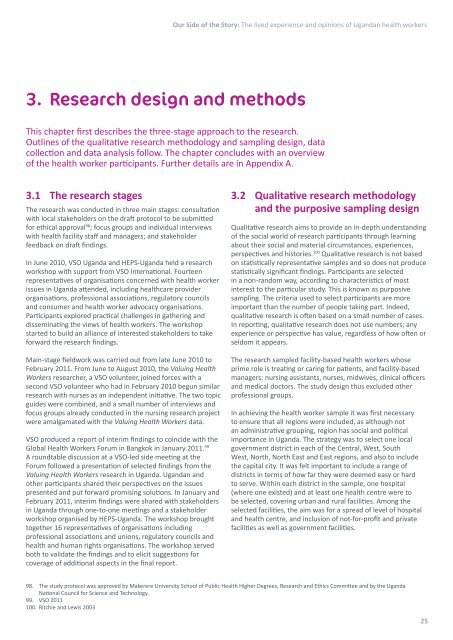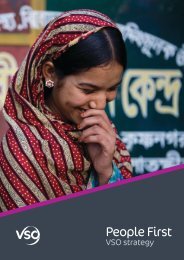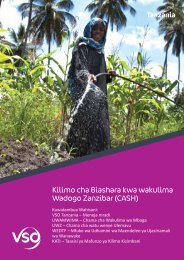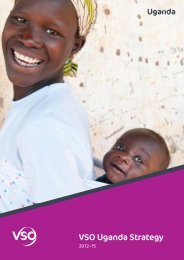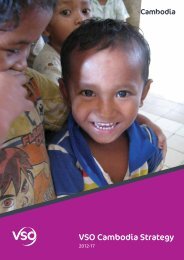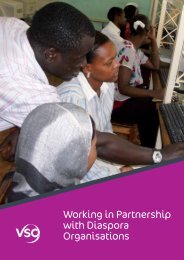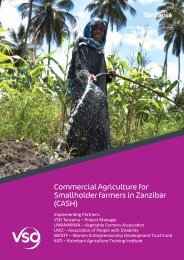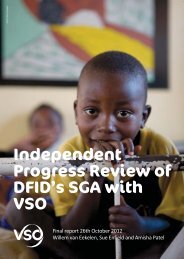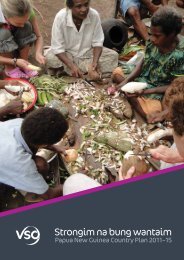Our Side of the Story - VSO
Our Side of the Story - VSO
Our Side of the Story - VSO
- No tags were found...
Create successful ePaper yourself
Turn your PDF publications into a flip-book with our unique Google optimized e-Paper software.
<strong>Our</strong> <strong>Side</strong> <strong>of</strong> <strong>the</strong> <strong>Story</strong>: The lived experience and opinions <strong>of</strong> Ugandan health workers3. Research design and methodsThis chapter first describes <strong>the</strong> three-stage approach to <strong>the</strong> research.Outlines <strong>of</strong> <strong>the</strong> qualitative research methodology and sampling design, datacollection and data analysis follow. The chapter concludes with an overview<strong>of</strong> <strong>the</strong> health worker participants. Fur<strong>the</strong>r details are in Appendix A.3.1 The research stagesThe research was conducted in three main stages: consultationwith local stakeholders on <strong>the</strong> draft protocol to be submittedfor ethical approval 98 ; focus groups and individual interviewswith health facility staff and managers; and stakeholderfeedback on draft findings.In June 2010, <strong>VSO</strong> Uganda and HEPS-Uganda held a researchworkshop with support from <strong>VSO</strong> International. Fourteenrepresentatives <strong>of</strong> organisations concerned with health workerissues in Uganda attended, including healthcare providerorganisations, pr<strong>of</strong>essional associations, regulatory councilsand consumer and health worker advocacy organisations.Participants explored practical challenges in ga<strong>the</strong>ring anddisseminating <strong>the</strong> views <strong>of</strong> health workers. The workshopstarted to build an alliance <strong>of</strong> interested stakeholders to takeforward <strong>the</strong> research findings.Main-stage fieldwork was carried out from late June 2010 toFebruary 2011. From June to August 2010, <strong>the</strong> Valuing HealthWorkers researcher, a <strong>VSO</strong> volunteer, joined forces with asecond <strong>VSO</strong> volunteer who had in February 2010 begun similarresearch with nurses as an independent initiative. The two topicguides were combined, and a small number <strong>of</strong> interviews andfocus groups already conducted in <strong>the</strong> nursing research projectwere amalgamated with <strong>the</strong> Valuing Health Workers data.<strong>VSO</strong> produced a report <strong>of</strong> interim findings to coincide with <strong>the</strong>Global Health Workers Forum in Bangkok in January 2011. 99A roundtable discussion at a <strong>VSO</strong>-led side meeting at <strong>the</strong>Forum followed a presentation <strong>of</strong> selected findings from <strong>the</strong>Valuing Health Workers research in Uganda. Ugandan ando<strong>the</strong>r participants shared <strong>the</strong>ir perspectives on <strong>the</strong> issuespresented and put forward promising solutions. In January andFebruary 2011, interim findings were shared with stakeholdersin Uganda through one-to-one meetings and a stakeholderworkshop organised by HEPS-Uganda. The workshop broughttoge<strong>the</strong>r 16 representatives <strong>of</strong> organisations includingpr<strong>of</strong>essional associations and unions, regulatory councils andhealth and human rights organisations. The workshop servedboth to validate <strong>the</strong> findings and to elicit suggestions forcoverage <strong>of</strong> additional aspects in <strong>the</strong> final report.3.2 Qualitative research methodologyand <strong>the</strong> purposive sampling designQualitative research aims to provide an in-depth understanding<strong>of</strong> <strong>the</strong> social world <strong>of</strong> research participants through learningabout <strong>the</strong>ir social and material circumstances, experiences,perspectives and histories. 100 Qualitative research is not basedon statistically representative samples and so does not producestatistically significant findings. Participants are selectedin a non-random way, according to characteristics <strong>of</strong> mostinterest to <strong>the</strong> particular study. This is known as purposivesampling. The criteria used to select participants are moreimportant than <strong>the</strong> number <strong>of</strong> people taking part. Indeed,qualitative research is <strong>of</strong>ten based on a small number <strong>of</strong> cases.In reporting, qualitative research does not use numbers; anyexperience or perspective has value, regardless <strong>of</strong> how <strong>of</strong>ten orseldom it appears.The research sampled facility-based health workers whoseprime role is treating or caring for patients, and facility-basedmanagers: nursing assistants, nurses, midwives, clinical <strong>of</strong>ficersand medical doctors. The study design thus excluded o<strong>the</strong>rpr<strong>of</strong>essional groups.In achieving <strong>the</strong> health worker sample it was first necessaryto ensure that all regions were included, as although notan administrative grouping, region has social and politicalimportance in Uganda. The strategy was to select one localgovernment district in each <strong>of</strong> <strong>the</strong> Central, West, SouthWest, North, North East and East regions, and also to include<strong>the</strong> capital city. It was felt important to include a range <strong>of</strong>districts in terms <strong>of</strong> how far <strong>the</strong>y were deemed easy or hardto serve. Within each district in <strong>the</strong> sample, one hospital(where one existed) and at least one health centre were tobe selected, covering urban and rural facilities. Among <strong>the</strong>selected facilities, <strong>the</strong> aim was for a spread <strong>of</strong> level <strong>of</strong> hospitaland health centre, and inclusion <strong>of</strong> not-for-pr<strong>of</strong>it and privatefacilities as well as government facilities.98. The study protocol was approved by Makerere University School <strong>of</strong> Public Health Higher Degrees, Research and Ethics Committee and by <strong>the</strong> UgandaNational Council for Science and Technology.99. <strong>VSO</strong> 2011100. Ritchie and Lewis 200325


